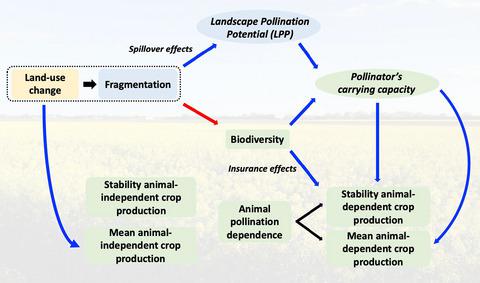Our official English website, www.x-mol.net, welcomes your
feedback! (Note: you will need to create a separate account there.)
Habitat fragmentation and food security in crop pollination systems
Journal of Ecology ( IF 5.3 ) Pub Date : 2021-05-22 , DOI: 10.1111/1365-2745.13713 Daniel Montoya 1, 2, 3 , Bart Haegeman 3 , Sabrina Gaba 4, 5 , Claire De Mazancourt 3 , Michel Loreau 3
中文翻译:

作物授粉系统中的栖息地破碎化和粮食安全
更新日期:2021-05-22
Journal of Ecology ( IF 5.3 ) Pub Date : 2021-05-22 , DOI: 10.1111/1365-2745.13713 Daniel Montoya 1, 2, 3 , Bart Haegeman 3 , Sabrina Gaba 4, 5 , Claire De Mazancourt 3 , Michel Loreau 3
Affiliation

|
- Ensuring stable food supplies is a major challenge for the 21st century. There is consensus that increased food production is necessary, but not sufficient, to achieve food security, and that agriculture should also aim at stabilizing crop production over time. In this context, biodiversity-based approaches to food security are increasingly being supported based on the fact that biodiversity can increase and stabilize crop production. However, agricultural systems are often highly fragmented and our current understanding of how such fragmentation affects biodiversity and food production remains incomplete, thus limiting our capacity to manage agricultural landscapes for food security.
- We developed a spatially explicit model of crop dynamics to investigate how the fragmentation of natural habitats for agricultural conversion impacts food production and food security, with a focus on animal-dependent crop production.
- Fragmentation produces a variety of spatial and biodiversity-mediated effects that affect both the mean and stability (temporal invariability) of animal-dependent crop production.
- Fragmentation has a dual effect on animal-dependent production. On the one hand, spatial aggregation of natural land decreases animal-dependent production by reducing the Landscape Pollination Potential, a metric that captures fragmentation and pollinator spillover effects within the agricultural landscape. But aggregation increases animal-dependent production by maintaining a higher pollinator diversity in larger fragments of natural habitat. The net effects of fragmentation on animal-dependent crop production depend on the land-use change pattern, the strength of the pollinator spillover to crop land and the animal pollination dependence of crops.
- Synthesis. Our study sheds new light in the food security debate by showing that high and stable crop production depends on biodiversity and the spatial fragmentation of agricultural landscapes, and by revealing the ecological mechanisms of food security in crop pollination systems. Management for food security should consider factors such as pollinators’ spillover, the amount and spatial aggregation of semi-natural habitat and the animal pollination dependence of crops. This information would be useful to design agricultural landscapes for high Landscape Pollination Potential. These results are highly relevant in the global change context, and given the worldwide trends in agriculture, which shifts towards more animal-dependent crop production.
中文翻译:

作物授粉系统中的栖息地破碎化和粮食安全
- 确保稳定的粮食供应是 21 世纪的一项重大挑战。人们一致认为,为了实现粮食安全,增加粮食产量是必要的,但还不够,农业还应以长期稳定作物产量为目标。在此背景下,基于生物多样性的粮食安全方法越来越受到支持,因为生物多样性可以增加和稳定作物生产。然而,农业系统往往高度分散,我们目前对这种分散如何影响生物多样性和粮食生产的理解仍然不完整,从而限制了我们为粮食安全管理农业景观的能力。
- 我们开发了一个空间明确的作物动态模型,以研究农业转化的自然栖息地的破碎如何影响粮食生产和粮食安全,重点是依赖动物的作物生产。
- 碎片化会产生各种空间和生物多样性介导的影响,影响依赖动物的作物生产的均值和稳定性(时间不变性)。
- 碎片化对依赖动物的生产有双重影响。一方面,自然土地的空间聚集通过降低景观授粉潜力来减少依赖动物的生产,景观授粉潜力是捕捉农业景观中的碎片化和传粉媒介溢出效应的指标。但是聚集通过在较大的自然栖息地片段中保持较高的传粉媒介多样性来增加依赖动物的生产。碎片化对依赖动物的作物生产的净影响取决于土地利用变化模式、传粉媒介对作物土地的外溢强度以及作物对动物授粉的依赖。
- 合成。我们的研究表明,高而稳定的作物产量取决于生物多样性和农业景观的空间碎片化,并揭示作物授粉系统中粮食安全的生态机制,从而为粮食安全辩论提供了新的思路。粮食安全管理应考虑传粉媒介的外溢、半自然栖息地的数量和空间聚集以及作物对动物授粉的依赖等因素。这些信息对于设计具有高景观授粉潜力的农业景观非常有用。这些结果在全球变化背景下高度相关,并考虑到全球农业趋势,农业转向更加依赖动物的作物生产。











































 京公网安备 11010802027423号
京公网安备 11010802027423号